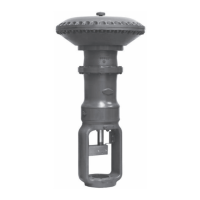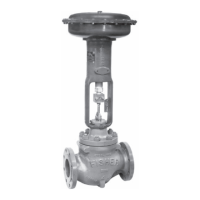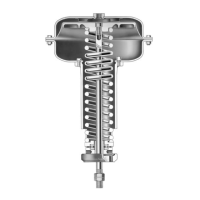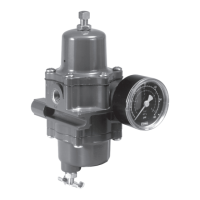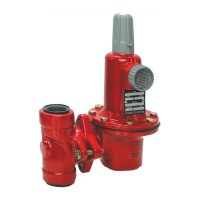Instruction Manual
D100310X012
667 Actuator (Size 30/30i - 76/76i and 87)
May 2018
21
Side‐Mounted Handwheel Assembly for Size 70, 76, and 87 Actuators
A side‐mounted handwheel assembly (figure 20) is usually used as a manual actuator. Turning the handwheel
clockwise past the neutral position always closes the valve body. A sleeve (key 123, figure 20) on a handwheel
assembly for a size 70, 76 or 87 actuator opens the valve body by moving the valve stem.
Instructions are given below for complete disassembly and assembly. Perform the disassembly only as far as necessary
to accomplish the required maintenance; and then begin the assembly at the appropriate step.
Disassembly for Side‐Mounted Handwheel (Sizes 70, 76, and 87)
1. Bypass the control valve. Reduce the loading pressure to atmospheric. Disconnect the loading pressure tubing or
piping at the yoke.
2. Remove the cover band (key 87), and relieve spring compression by turning the spring adjuster (key 74)
counterclockwise.
3. Remove the cap screws and nuts (keys 13 and 14) and lift off the upper diaphragm casing (key 1).
4. Remove the travel stop screw (key 12) and spacer (key 2), and take off the diaphragm plate (key 4), the diaphragm
(key 3), and the lower diaphragm plate (key 71).
5. Unscrew the cap screws (key 90) and remove the following connected parts: the lower diaphragm casing (key 64),
the O‐ring (key 70), spring case adaptor (key 89), the seal bushing, O‐rings, and snap ring (keys 7, 8, 9, and 72).
6. Remove the snap ring (key 72), and slide the seal bushing and O‐rings (keys 7, 8, and 9) out of the spring case
adaptor (key 89).
7. Take out the actuator spring (key 18).
8. Remove the stem connector (key 31) and stem connector cap screws.
9. Pull the actuator stem (key 144) up and out of the yoke. The spring seat (key 19), spring adjuster (key 74), thrust
bearing (key 128), and the pinned adjusting screw (key 131) will come out with the actuator stem.
10. Turn the handwheel so that the lower sleeve (key 123) extends out of the bottom of the yoke. DO NOT move the
neutral indicator scale (key 125).
11. Loosen two set screws (key 121), and unscrew the bearing retainer flange (key 45). Take out the worm gear and
two thrust bearings (key 132), one on each side of the gear.
12. The worm shaft (key 51) and associated parts can be disassembled, if desired, by first removing the handwheel nut
(key 127) and the handwheel (key 58). Do not lose the small ball (key 141) and spring (key 142).
13. Loosen the set screw (key 52) for each worm shaft retainer (keys 48 and 49). Unscrew the two worm retainers
(keys 48 and 49). The ball bearings (key 50) will come out with the retainers.
Assembly for Side‐Mounted Handwheel (Sizes 70, 76, and 87)
1. The front and back worm retainers (keys 48 and 49) each have a slot in their threads for a set screw (key 52). Pack
the ball bearings (key 50) with anti‐seize lubricant (key 239), and insert one ball bearing in the back worm retainer
(key 49) as shown in figure 20.
2. Thread the back bearing retainer and ball bearing (keys 49 and 50) into the yoke. Align the slot in the bearing
retainer with the set screw hole in the yoke, insert the set screw (key 52), and tighten it.
3. Coat the worm shaft (key 51) threads with anti‐seize lubricant (key 239), and slide the shaft into the yoke so that
the end of the shaft fits snugly into the back bearing retainer.
4. Insert the bearing in the front bearing retainer (key 49), and thread the retainer and ball bearing into the yoke. Align
the slot in the retainer with the hole in the yoke, insert the set screw (key 52), and tighten it.
5. Put the spring and ball (keys 141 and 142) in the handwheel (key 58). Slide the handwheel onto the worm shaft (key
51). Thread the hex nut (key 127) onto the worm shaft.
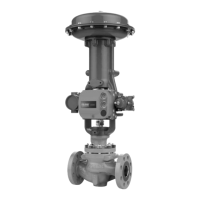
